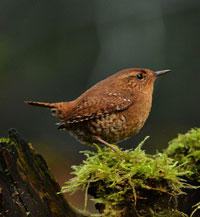Olompali State Historic Park
Those woods up the hill - that's where you're headed. Photo by Fred Davis.
Click here for printable pdf
Olompali State Historic Park encompasses a cluster of historical buildings and the wooded slopes that rise above them to the summit of Mount Burdell on the northern border of Novato. As with our other parks of mostly north-facing slopes (Indian Valley and much of Indian Tree), these topographical conditions favor more continuous woodland compared to the sunnier and more open south-facing areas, a habitat accessible in the case of this 1558’ “mountain” in the adjoining Mount Burdell Open Space Preserve. This mixed oak woodland is the dominant ecosystem at Olompali, but the twists and turns of the park’s trails offer a gently varying array of plant and animal life.
Down Below: Gardens, Orchards, and Open FieldsThe entrance to the park quickly leads you into the remains of a garden and a number of buildings of varying antiquity. Plentiful interpretive signs provide historical context, from the remains of Camilo Ynitia’s adobe (“the oldest house in the Bay Area,” dating from 1837), to Mary Burdell’s fancy garden of exotic plants and Olompali’s 60s period hosting the Grateful Dead and then the hippie commune known as “the Chosen Family.” All of which is quite fascinating in its own right. From the naturalist’s perspective, it is interesting (and a bit Ozymandian) to observe how the wildlife has taken over these generally unmaintained buildings, from the thriving ground squirrel colonies to the abundant turkeys tromping through the untended orchards. Massive eucalyptuses host noisy flocks of starlings, while native woodpeckers, nuthatches, titmice, and chickadees travel between the live oaks and the more amenable of the exotic plants. The more open areas near the entrance also host raptors like red-tailed hawks and American kestrels, as well as open country insect-eaters like western bluebirds and a variety of swallow species. Woodland SongbirdsAs you walk past the residential complex and then past the old dairy barn, a path crosses a small bridge to your left. This is one end of the loop trail which also continues forward on the main path, covering some 2.7 miles and a few hundred feet of elevation gain. For a longer walk, your one other option is to continue forward, past the recreated Miwok structures (“Olompali” is a Miwok name for the settlement here, by the way, thought to mean something like “southern village”), and then turn right at the fork for the switchbacking trail up to Mount Burdell’s summit, some four miles and nearly 1600’ later. If you continue forward on the main path towards the Miwok kotchas, you’ll quickly transition towards a more natural plant community. A patch of coyote bush immediately past the buildings is a good place to look for singing house wrens and wheezing blue-gray gnatcatchers in summer. This lower section is rich with wildflowers and birdsong in spring, with plentiful voices from our “easy to hear, harder to see” summer chorus, including warbling vireos, orange-crowned warblers, and purple finches in addition to the somewhat more visible dark-eyed juncos and oak titmice. A sudden clumsy explosion from the treetops might reveal the presence of band-tailed pigeons, our flocking forest pigeon which roams over our ridgeline forests in search of acorns, madrone berries, or whatever else is in season. Moving forward, your path will generally become increasingly wooded, with a parallel change in birds, all of whom have their own particular niche of plants and prey. For instance, 15 minutes’ walking will take you along the flycatcher spectrum from the open-meadow bluebirds near the entrance to the human-friendly black phoebes around the garden to the summering ash-throated flycatchers in the oak woods to the pacific-slope flycatchers who favor the denser bay woods near the creek. Olompali is a particularly fine site for woodpecker watching. All seven of our local species can be found here, including the common and familiar little downy woodpecker, the ladder-backed Nuttall’s woodpecker, and the oak specialist acorn woodpeckers (who particularly enjoy Mary Burdell’s palm trees). But our four less common woodpeckers can also be found here:
Special Bits As You ClimbMost of the trail passes through variations on this type of mixed woodland: here a patch dominated by handsome madrones, there mostly live oaks and bays, and then a bit of somewhat sunnier woods with valley or blue oaks and a grassier understory. Depending on the season, many bird species can be found crossing these nebulous transitions as they pursue the varied seeds and insects across this mosaic of plants. There are a few more dramatic shifts in habitat worth noting, however. On both the main ascending Mount Burdell trail and on the loop trail, the path will cross over suddenly steeper canyons cut by mostly seasonal creeks. These moister interludes, shaded by the dark evergreen leaves of bays and carpeted with ferns, are good places to look among the low vegetation for dark and diminutive pacific wrens. In addition to being a good multi-woodpecker park, Olompali is also Novato’s best park to achieve a “three wren” day, with the common Bewick’s in mixed woodland and chaparral, house wrens in the lower, more open areas, and pacific wrens in the ferny interludes (cross the highway to Rush Creek and Bahia for marsh wrens, our fourth local member of the cocked-tail tribe). These shady canyons may also be punctuated by the harsh calls of Steller’s jays in the treetops, or graced in winter by the elusive silhouettes of varied thrushes. As you approach the summit, you’ll also pass through some areas of fewer, smaller trees and drier and more exposed conditions: the chaparral. Lower thickets of coyote bush, manzanita, or chamise host Bewick’s wrens, wrentits (a non-wren, non-tit, honorary member of that cocked-tail brigade, who loves to announce his presence with a loud “bouncing ball” song), or scurrying quail. These more open areas also give you opportunities to assess the views out over Rush Creek and the Petaluma River. Once you reach the top and pass through the gate into Open Space land, a few picnic tables offer commodious seating from whence to enjoy these views at full leisure, the sky dotted with the swift flights of pigeons, the regular transits of crows, and the lazy circles of red-tailed hawks and turkey vultures. |
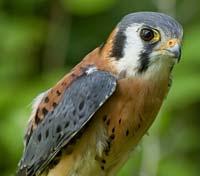
American Kestrel |
|
|
|
|
|
|
|
|
|
|
Pacific Wren Jacob McGinnis |
Practical Details
How to Get There: From Atherton/San Marin exit in northern Novato, head west on San Marin Dr. but turn right immediately onto Redwood Blvd. Go past the Atherton SMART station and continue to the end of Redwood, which ends in the park (a fancy wide bike path continues directly north to Petaluma). You can also hike into the park over the top of Mount Burdell, though any out-and-back trip from the Burdell side is going to involve some ~4 miles just to get to the Olompali border near the peak. Arranging a car shuttle for a one-way trip is a good option.
Rules & Access: Olompali is a California State Historic Park, which means that it has more facilities and more costs than the minimalist county open space preserves which make up most of Novato’s public land. There is plentiful parking and picnic tables, portable toilets, and a limited hours visitor’s center (usually open 12-3 on Saturdays). There is also an $8 parking fee (State Park passes also accepted). The park is currently open from 9-5 from Wednesday through Sunday. No bikes or dogs permitted.
- Return to Birding Sites Homepage -


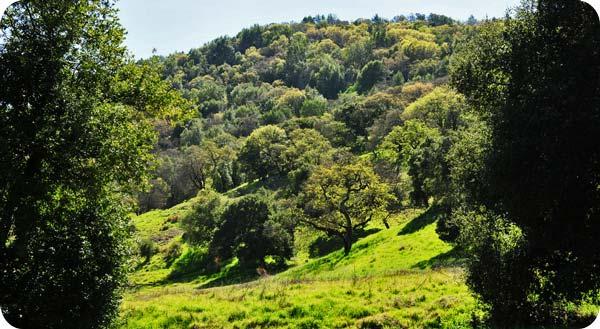
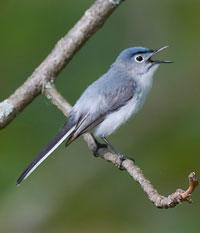 Blue-gray Gnatcatcher
Blue-gray Gnatcatcher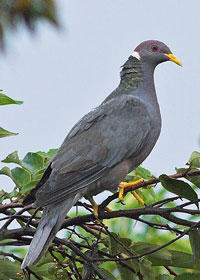 Band-tailed Pigeon
Band-tailed Pigeon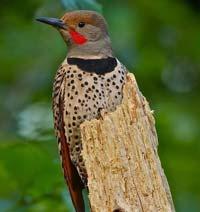 Northern Flicker
Northern Flicker